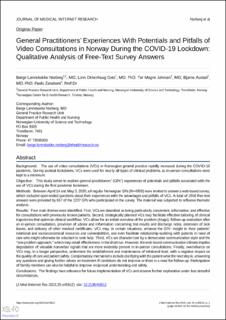| dc.description.abstract | Background:
The use of video consultations (VCs) in Norwegian general practice rapidly increased during the COVID-19 pandemic. During societal lockdowns, VCs were used for nearly all types of clinical problems, as in-person consultations were kept to a minimum.
Objective:
This study aimed to explore general practitioners’ (GPs’) experiences of potentials and pitfalls associated with the use of VCs during the first pandemic lockdown.
Methods:
Between April 14 and May 3, 2020, all regular Norwegian GPs (N=4858) were invited to answer a web-based survey, which included open-ended questions about their experiences with the advantages and pitfalls of VCs. A total of 2558 free-text answers were provided by 657 of the 1237 GPs who participated in the survey. The material was subjected to reflexive thematic analysis.
Results:
Four main themes were identified. First, VCs are described as being particularly convenient, informative, and effective for consultations with previously known patients. Second, strategically planned VCs may facilitate effective tailoring of clinical trajectories that optimize clinical workflow. VCs allow for an initial overview of the problem (triage), follow-up evaluation after an in-person consultation, provision of advice and information concerning test results and discharge notes, extension of sick leaves, and delivery of other medical certificates. VCs may, in certain situations, enhance the GPs’ insight in their patients’ relational and socioeconomical resources and vulnerabilities, and even facilitate relationship-building with patients in need of care who might otherwise be reluctant to seek help. Third, VCs are characterized by a demarcated communication style and the “one problem approach,” which may entail effectiveness in the short run. However, the web-based communication climate implies degradation of valuable nonverbal signals that are more evidently present in in-person consultations. Finally, overreliance on VCs may, in a longer perspective, undermine the establishment and maintenance of relational trust, with a negative impact on the quality of care and patient safety. Compensatory mechanisms include clarifying with the patient what the next step is, answering any questions and giving further advice on treatment if conditions do not improve or there is a need for follow-up. Participation of family members can also be helpful to improve reciprocal understanding and safety.
Conclusions:
The findings have relevance for future implementation of VCs and deserve further exploration under less stressful circumstances. | en_US |

